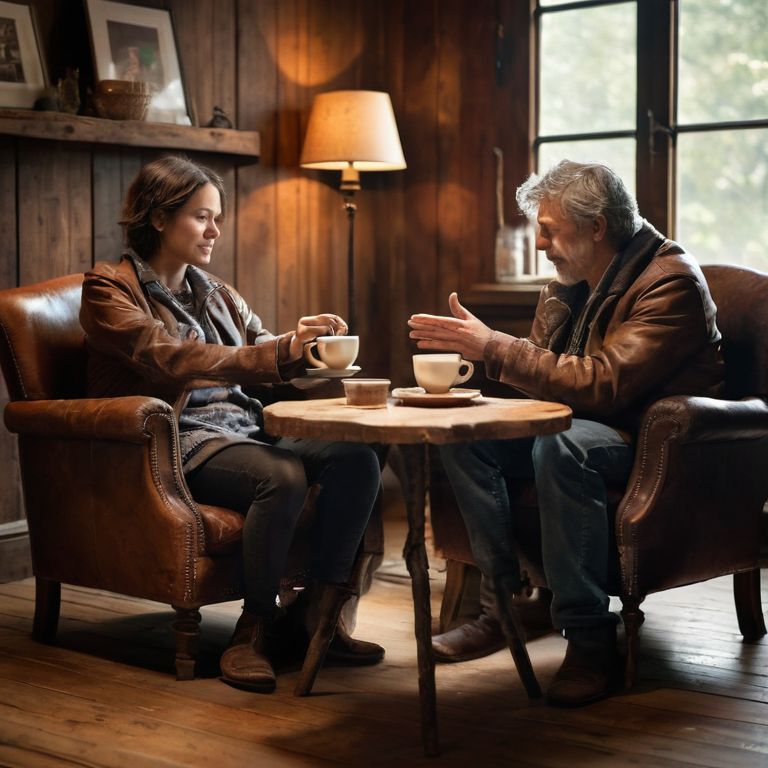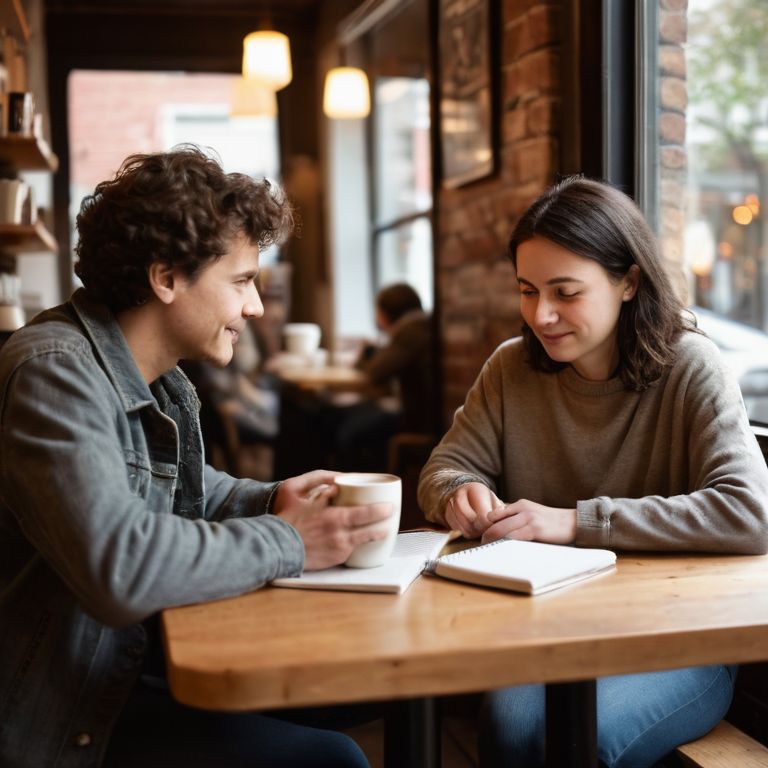I still remember the first time I struggled to ask open-ended questions in a conversation. I was mediating a dispute in an online community, and I found myself stuck in a cycle of yes or no answers. It wasn’t until I learned the art of crafting questions that sparked meaningful discussions that I began to see real progress. The truth is, learning how to ask open-ended questions is not about being inherently curious, but rather about developing a skill that can be practiced and mastered.
In this article, I’ll share my personal approach to asking open-ended questions, one that has helped my clients and friends build stronger, more authentic relationships. You’ll learn how to move beyond simple yes or no questions and instead, unleash the power of curiosity in your conversations. I’ll provide you with practical tips, real-life examples, and actionable scripts to help you navigate even the most challenging discussions. By the end of this guide, you’ll be equipped with the skills to ask open-ended questions that foster deeper connections and more meaningful interactions.
Table of Contents
Guide Overview: What You'll Need

Total Time: 30 minutes to 1 hour
Estimated Cost: Free – $0
Difficulty Level: Easy
Tools Required
- Pen for note-taking
- Paper for jotting down questions
Supplies & Materials
- None just your curiosity and willingness to learn
Step-by-Step Instructions
- 1. First, let’s start by understanding what makes a question open-ended. These are questions that can’t be answered with a simple “yes” or “no,” and they encourage the other person to share their thoughts and feelings. To craft such questions, try starting with what, how, or why, as these words naturally lead to more in-depth discussions.
- 2. Next, practice active listening by paying close attention to the other person’s responses. This means maintaining eye contact, nodding to show you’re engaged, and avoiding interrupting, even if you think you know what they’re going to say. Active listening helps create a safe space for open and honest communication, making it more likely that the other person will open up to you.
- 3. Now, let’s talk about the art of reframing questions. Sometimes, we ask questions without realizing they’re actually leading the conversation in a specific direction. To avoid this, try to rephrase your questions in a more neutral way. For example, instead of asking “Don’t you think this is a good idea?”, ask “What are your thoughts on this idea?” This simple reframe can make a big difference in how the other person responds.
- 4. The fourth step is to use non-verbal cues to show you’re interested in the conversation. This can include leaning forward, uncrossing your arms, or making gentle gestures with your hands. These non-verbal signals can help put the other person at ease and encourage them to share more, which is essential for asking open-ended questions that lead to meaningful conversations.
- 5. Fifth, avoid giving unsolicited advice, as this can quickly shut down the conversation. When someone shares their thoughts or feelings with you, try to resist the urge to offer a solution right away. Instead, ask follow-up questions like “How did that make you feel?” or “What do you think you might do next?” This helps to keep the conversation focused on the other person’s needs and thoughts.
- 6. Next, learn to pause and wait for the other person to respond. It can be tempting to fill silence with more questions or comments, but this can come across as pushy or insincere. By pausing and giving the other person space to think and respond, you’re showing that you value their thoughts and opinions, which can lead to more open and honest discussions.
- 7. Seventh, try to get curious about the other person’s perspective, even if you don’t agree with it. Ask questions that help you understand where they’re coming from, such as “Can you help me understand why you feel that way?” or “What led you to that conclusion?” This kind of curiosity can help to build bridges and create a more supportive and non-judgmental space for open-ended questions.
- 8. Finally, practice self-reflection after each conversation to think about what worked well and what didn’t. Ask yourself questions like “Did I interrupt or dominate the conversation?” or “Were there moments where I could have asked more open-ended questions?” By reflecting on your own communication style, you can identify areas for improvement and become more skilled at asking open-ended questions that lead to deeper, more meaningful connections with others.
Unlocking Deeper Conversations

As we explore the art of sparking meaningful conversations, it’s essential to consider the role of techniques for active listening. When we truly listen to others, we create a safe space for them to open up and share their thoughts and feelings. This, in turn, fosters a deeper connection and encourages the other person to ask more thoughtful questions in return. By focusing on the conversation rather than just our next question, we can uncover new insights and perspectives.
In addition to active listening, conversational storytelling methods can be a powerful tool for unlocking deeper conversations. When we share our own stories and experiences, we create a sense of mutual understanding and trust. This can help to break down barriers and encourage others to do the same, leading to more authentic and meaningful interactions. By being vulnerable and open, we can create a ripple effect of empathy and connection.
To take our conversations to the next level, it’s crucial to be mindful of nonverbal cues and practicing empathy in dialogue. Our body language and tone of voice can convey just as much information as our words, and being aware of these subtle signals can help us navigate even the most challenging conversations with ease. By combining these skills with thoughtful, open-ended questions, we can create a rich and supportive environment for connection and growth to flourish.
Asking Open Ended Questions With Active Listening
When I’m hosting board game nights, I notice how easily conversations can stay surface-level. To dive deeper, I make sure to pair open-ended questions with active listening. This means maintaining eye contact, nodding to show I’m engaged, and avoiding interruptions. By doing so, I create a safe space for others to share their thoughts and feelings. Active listening is just as crucial as the questions themselves, as it shows that I value and respect the other person’s perspective.
As I listen, I also pay attention to nonverbal cues and reflect back what I’ve heard to ensure understanding. This helps to build trust and encourages the other person to open up even more. By combining open-ended questions with active listening, we can unlock more meaningful and intimate conversations, even in casual settings. This powerful combination can be applied to any interaction, from romantic relationships to friendships and professional connections.
Beyond Yes or No Practicing Empathy
As I reflect on my own experiences hosting board game nights, I’ve noticed how empathy can be a game-changer in conversations. When someone shares their thoughts or feelings, I try to acknowledge and understand their perspective. I might say, “Just to make sure I understand, can you help me see why this is important to you?” or “I sense that you’re feeling frustrated, can you tell me more about what’s driving that feeling?” By doing so, I create a safe space for them to open up and share more. This helps to build trust and encourages more meaningful discussions.
In my partner acrobatics practice, I’ve learned that active listening is crucial. When my partner is sharing their concerns or needs, I make sure to give them my full attention. I use phrases like “I hear you saying…” or “It sounds like…” to show that I’m engaged and care about their thoughts. By practicing empathy in our daily conversations, we can turn potentially contentious discussions into opportunities for growth and deeper connection.
Curiosity in Action: 5 Tips to Master Open-Ended Questions
- Start with what sparks your genuine curiosity, and phrase your question around that, making sure it can’t be answered with a simple ‘yes’ or ‘no’
- Use open-ended question starters like ‘what,’ ‘how,’ or ‘why’ to encourage the other person to share their thoughts and feelings in depth
- Practice active listening by maintaining eye contact, nodding, and summarizing what the other person says, which helps in crafting follow-up questions that delve deeper into the conversation
- Avoid leading questions or ones that make assumptions, and instead opt for neutral, non-judgmental phrasing that allows the other person to express themselves freely
- Embrace silence after asking a question, giving the other person the space and time they need to reflect and respond thoughtfully, which often leads to more meaningful and revealing answers
Key Takeaways for Deeper Connections
Practice empathy by recognizing the emotions and needs behind someone’s words, and respond with understanding to create a safe space for open conversation
Use active listening skills to inform your open-ended questions, ensuring they are relevant and thoughtful, and encouraging the other person to share more
Integrate open-ended questions into your daily interactions by starting with simple prompts like ‘What was the highlight of your week?’ or ‘How did you feel about that experience?’ to spark meaningful discussions and build stronger relationships
The Art of Curiosity
Asking open-ended questions is not just about seeking information, but about sparking a dance of discovery, where every response is an invitation to deepen the conversation and understand the beauty of another’s perspective.
Mia Campbell
Embracing the Art of Open-Ended Questions

As we’ve explored throughout this guide, learning how to ask open-ended questions is a powerful tool for unlocking deeper, more meaningful conversations. By combining these questions with active listening, we can create a safe and supportive space for others to express themselves freely. This, in turn, fosters empathy and understanding, helping to break down barriers and build stronger, more resilient relationships. Whether in our personal or professional lives, the ability to spark engaging and insightful discussions is a valuable skill that can lead to greater connection, collaboration, and mutual growth.
As you continue on your journey to master the art of open-ended questions, remember that it’s a process of discovery and growth, both for yourself and those you interact with. By embracing this approach, you’ll find that conversations become more enriching and rewarding, allowing you to tap into the wealth of experiences, perspectives, and insights that surround you. So, go ahead, ask those questions, and watch as your relationships flourish and your understanding of the world and its complexities deepens.
Frequently Asked Questions
How can I ensure my open-ended questions don't feel like an interrogation?
To avoid making your open-ended questions feel like an interrogation, try framing them as genuine curiosity, using phrases like “I’ve been wondering” or “I’m curious about.” This helps shift the tone from questioning to conversation, making the other person feel more at ease and heard.
What if the person I'm asking doesn't respond thoughtfully to open-ended questions, how can I still have a meaningful conversation?
That’s a great challenge. If someone doesn’t respond thoughtfully, try reflecting back what you’ve heard to show you’re engaged, and then gently nudge them with a follow-up question, like “Can you tell me more about that?” or “How did you come to that conclusion?” This can help them open up and share more.
Are there any specific open-ended question techniques that work best in difficult or sensitive conversations?
In tough conversations, I swear by the “What’s beneath that?” technique. It helps you gently dig deeper into the other person’s feelings and concerns. For example, if they say “I’m just really frustrated,” you can respond with “What’s beneath that frustration for you?” to uncover the root issue and create a safer space for discussion.
